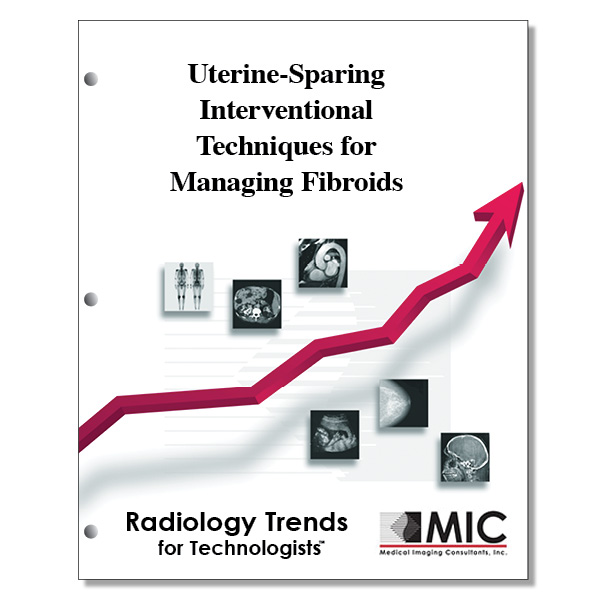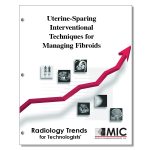

Uterine-Sparing Interventional Techniques for Managing Fibroids
A discussion of uterine fibroids and their diagnosis, pharmacotherapy, surgical treatment, and non-surgical interventional treatment including uterine artery embolization, and magnetic resonance-guided ultrasound.
Course ID: Q00501 Category: Radiology Trends for Technologists Modalities: MRI, Sonography, Vascular Interventional2.5 |
Satisfaction Guarantee |
$29.00
- Targeted CE
- Outline
- Objectives
Targeted CE per ARRT’s Discipline, Category, and Subcategory classification for enrollments starting after February 14, 2023:
[Note: Discipline-specific Targeted CE credits may be less than the total Category A credits approved for this course.]
Magnetic Resonance Imaging: 0.25
Procedures: 0.25
Body: 0.25
Registered Radiologist Assistant: 2.00
Patient Care: 0.25
Patient Management: 0.25
Procedures: 1.75
Abdominal Section: 1.75
Sonography: 0.25
Procedures: 0.25
Gynecology: 0.25
Vascular-Interventional Radiography: 2.00
Patient Care: 0.25
Patient Interactions and Management: 0.25
Procedures: 1.75
Vascular Interventional Procedures: 1.75
Outline
- Introduction
- Clinical Features (Signs and Symotoms
- Imaging Classification
- Noninterventional and Surgical Treatment Options
- Pharmacotherapy
- Surgical Treartment
- Uterine Artery (Fibroid) Embolization
- Procedure History
- Pelvic Arterial Anatomy and Pitfalls
- Technical Details and Costs
- Patient Selection
- Outcomes
- Fertility and Pregnancy
- Focused Ultrasound Therapy
- Patient Selection
- Patient Preparation and Procedure
- Complications
- Outcomes
- Future Directions
- Conclusion
Objectives
Upon completion of this course, students will:
- know the other name of uterine fibroids
- describe the prevalence and average population statistics affected by uterine fibroids
- be familiar with uterine fibroids and their origin
- describe the symptoms associated with uterine fibroids
- understand the most common and least common types of fibroids and identify the symptoms associated with each type
- describe the advantages of MRI in the pretreatment planning of patients with fibroids
- know the medication therapies used to treat fibroids and their limitations
- discuss the surgical treatments of uterine fibroids
- identify the most common variations of uterine artery branching patterns
- describe the risks of inadvertent embolization of the cervicovaginal artery
- understand the importance of evaluating for utero-ovarian anastomosis prior to embolization
- discuss how the internal iliac arteries and uterine arteries are catheterized during UAE
- be familiar with embolic agents and their use in the embolization of fibroids
- describe how a physician can determine the endpoint of the UAE procedures
- identify practices patients should avoid post-UAE procedure
- discuss postembolization syndrome
- identify contraindications of the UAE procedure
- discuss post-UAE procedure outcomes
- be familiar with complications of UAE
- discuss complications of UAE in relation to fertility and pregnancy
- understand the development of MR-guided FUS for the treatment of symptomatic fibroids
- describe how FUS/HIFU is used to treat uterine fibroids
- define sonication
- understand how MRI is used to monitor FUS therapy during the ablation
- know the limitations of MR-guided FUS
- discuss factors to consider when selecting patients for MR-guided FUS
- be familiar with the techniques to displace the bowel prior to MR-guided FUS
- understand the pre-procedure preparation of a patient for MR-guided FUS
- identify the safe focal spot distance of the ultrasound to prevent sacral nerve damage in FUS therapy procedures
- be familiar with the use of electronic fiducial markers during FUS therapy
- identify the symptoms of complications during FUS therapy
- be familiar with post-procedure care of patients receiving FUS therapy
- discuss patient complications after MR-guided FUS therapy
- understand correlations between nonperfused volumes and FUS procedure outcomes
- identify imaging modalities currently being considered for future use in the treatment of uterine fibroids
